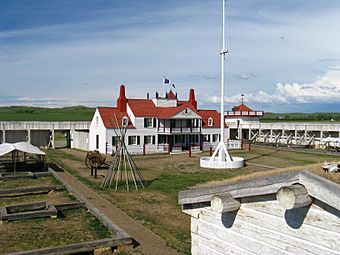Fort Union Trading Post National Historic Site facts for kids
|
Fort Union Trading Post National Historic Site
|
|

|
|
| Location | McKenzie and Williams counties, North Dakota, and Richland and Roosevelt counties, Montana |
|---|---|
| Nearest city | Williston, North Dakota |
| Area | 444 acres (1.80 km2) |
| Built | 1828 |
| Architectural style | Greek Revival |
| Visitation | 12,028 (2024) |
| Website | Fort Union Trading Post National Historic Site |
| NRHP reference No. | 66000103 (original) 100011805 (increase 1) 100011806 (increase 2) |
Quick facts for kids Significant dates |
|
| Added to NRHP | October 15, 1966 |
| Boundary increases | May 9, 2025 May 9, 2025 |
| Designated NHL | July 4, 1961 |
| Designated NHS | June 20, 1966 |
The Fort Union Trading Post National Historic Site is a special place that shows what an important fur trading post looked like. It's a partial reconstruction of the original fort. This fort was the busiest trading post on the upper Missouri River from 1829 to 1867.
You can find the fort site about two miles from where the Missouri River meets the Yellowstone River. It's on the North Dakota side of the North Dakota/Montana border. The nearest big town is Williston, North Dakota, about 25 miles away.
In 1961, the U.S. government recognized the site as a National Historic Landmark. This means it's a place with great historical importance. The National Park Service manages the site. They named it Fort Union Trading Post to avoid confusion with Fort Union National Monument in New Mexico.
Today, the historic site helps us imagine what the fort looked like in 1851. This is based on old drawings and things found by archaeologists. One important source was drawings by a Swiss artist named Rudolf Friedrich Kurz. He worked at the fort as a clerk in 1851.
Contents
The Fort's Early Days: A Hub for Trade
Fort Union was built around 1828 or 1829. It might have first been called Fort Henry or Fort Floyd. Kenneth McKenzie's Upper Missouri Outfit built and managed it. John Jacob Astor's American Fur Company provided the money for the fort. Astor's company was very powerful in the fur trade business.
Trading with Native American Tribes
Until 1867, Fort Union was the most important trading post on the upper Missouri River. It played a huge role in the fur trade in Montana. Many different Native American tribes came here to trade. These included the Assiniboine, Crow, Cree, Ojibwe, Blackfoot, Hidatsa, and Lakota tribes.
They traded buffalo robes and furs for goods made by Europeans and Americans. These trade goods included beads, clay pipes, guns, blankets, knives, and cooking tools.
Changing Fashions, Changing Trade
When the fort first opened, people in the East and Europe wanted beaver hats. So, Native Americans traded beaver pelts for goods. But in the 1830s, silk and wool hats became more popular. This meant less demand for beaver pelts. The trade then shifted to bison robes, which were still very valuable.
Fort Union's Role in the Frontier
Fort Union was a safe place for many people living on the frontier. It helped the economy grow in the American Northwest. As the main base for the American Fur Company, it was key to the fur trade's success. The fort's leaders, like John Jacob Astor, had a lot of influence on government decisions. These decisions often affected the Native American nations in the area. The fort also showed that the United States had a presence near its northern border.
Firearms and Hunting
The fort kept a large supply of firearms to trade with Native American tribes for furs. The tribes then used these firearms for hunting furs and buffalo. Many Northern Plains tribes preferred the "North West Gun." This was an English-made smooth-bore flintlock gun. It was known for being good quality and reliable.
Peace and Conflict at the Fort
There were fewer conflicts between European-American traders and Native Americans around Fort Union. However, there were sometimes conflicts among the Native American tribes themselves. In the summer of 1863, after the Dakota Wars of 1862, some tribes along the upper Missouri River became unfriendly towards white settlers. At times, Fort Union was almost surrounded. Steamboats and their passengers faced danger along the river.
Images for kids
See also
- Fort Buford, a nearby historic site
- Missouri-Yellowstone Confluence Interpretive Center
- Fur trade in Montana
- List of National Historic Landmarks in Montana
- National Register of Historic Places listings in Roosevelt County, Montana
- List of National Historic Landmarks in North Dakota
- National Register of Historic Places listings in Richland County, North Dakota




